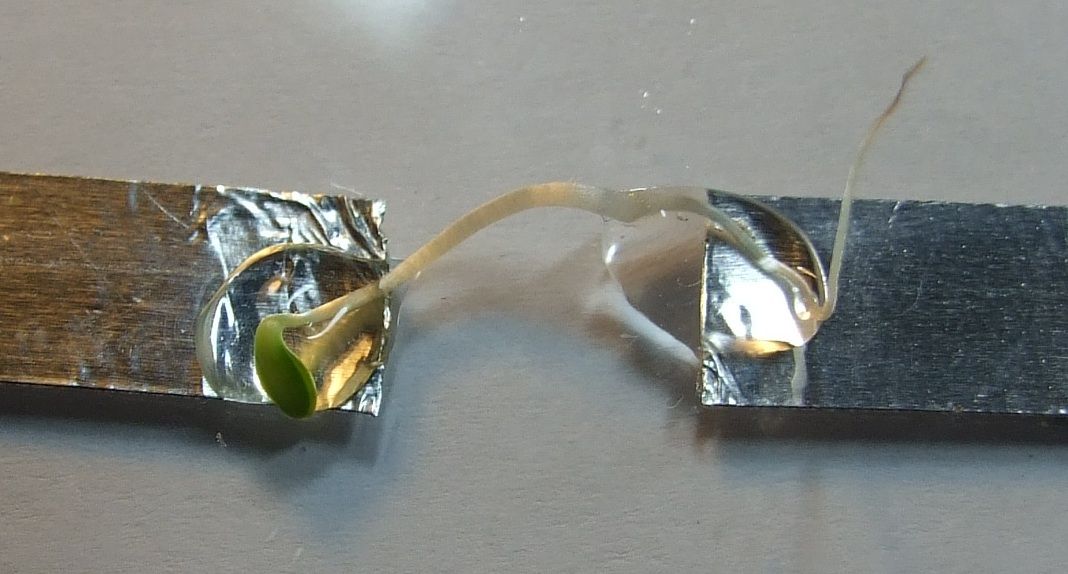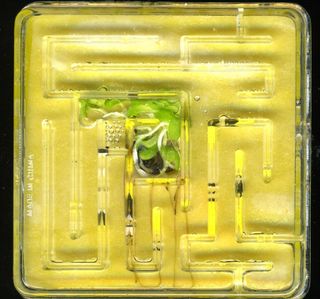Lettuce-Based Electric Wires Sprout in the Lab

LONDON — Move over, copper wires. The next generation of electricity cables may well be made from lettuce, based on the innovation of a U.K. researcher. The advance could pave the way to biological computers and bio-robots of the future.
Computer scientist Andrew Adamatzky of the University of West England did a series of tests with four-day-old lettuce seedlings. To create bio-wires, he bridged two electrodes made from conductive aluminum foil with a seedling that was placed onto the electrodes in drops of distilled water.
Next, he applied electrical potential between electrodes ranging from 2 to 12 volts, and calculated the seedling's so-called potential transfer function that shows output potential as a fraction of input potential — the amount of energy produced relative to energy put in. [Super-Intelligent Machines: 7 Robotic Futures]
He found that resistance of the seedling repetitively changed with time, or oscillated. He determined that, roughly, the output potential was 1.5-2 V less than the input potential, "so by applying 12 V potential we get 10 V output potential," he said.

This meant that the resistance showed aperiodic oscillations, and thus, the wire was "somewhat noisy." Such noise, he admits, is not ideal for creating sensors, because energy gets wasted. But once new methods are developed for reliable routing of the plant roots between living and silicon components, it may be possible to incorporate plant wires into bio-hybrid self-growing circuits.
For such a leap to happen, researchers will have to "find a way of navigating plant roots in labyrinths," Adamatzky writes in his paper, detailed in a pre-print published on the Arxiv website.
Humans and slime molds
Sign up for the Live Science daily newsletter now
Get the world’s most fascinating discoveries delivered straight to your inbox.
Almost any living creature, including humans, can conduct electricity and therefore be used as "wires," Adamatzky said. The problem is, not all creatures can remain motionless and without degrading for a long period of time. [Magnificent Microphotography: 50 Tiny Wonders]
But plants can — provided they get enough light, water and minerals.
Previously, Adamatzky and his team tried to use slime mold as a computing medium, but the resulting sensors and processor were "very fragile, highly dependent on environmental conditions and somewhat difficult to control and constrain."
So they searched for less shifty alternatives, deciding to go with plants, because they are "in general, more robust and resilient, less dependent on environmental conditions and can survive in a hostile environment of bio-hybrid electronic devices longer than slime molds do," Adamatzky said.
Although the lettuce-based prototype was a success, Adamatzky insists that talking about getting the bio-wires out of the lab and onto the market was at the moment premature; there are a lot of challenges to be overcome before the wires can become commercially viable, he said.
Physicist Victor Erokhin at the University of Parma in Italy, who was not involved in the study, said Adamatzky's findings are important. "It is interesting that living beings without nervous systems sometimes reveal 'intelligent’ behavior,'" he said.
"In this respect, such 'wires' can provide connections that will depend on the state of the environmental conditions. Moreover, such objects can be considered as bio-actuators," Erokhin said.
Ultimately, Erokhin believes, this research could lead to the development of bio-robots — where scientists stimulate the plant cells so that they follow a biological blueprint and grow into truly green machines.
The main challenge now is to understand the intelligent behavior of plants and slime mold, he added.
Biology solutions
It is not the first time researchers have turned to biology to create electronic components.
In 2013, a team of U.K. and U.S. scientists led by Tom Clarke, a lecturer at the school of biological sciences at the University of East Anglia (UEA), studied how marine bacteria conduct electricity to develop a model of microscopic bio-batteries.
And bio-physicist Angela Belcher at the Massachusetts Institute of Technology has succeeded in creating solar cells, plastics and more efficient batteries with the help of viruses.
Finally, U.S. scientists at Virginia Tech very recently developed a sugar-powered bio-battery. They claim it stores 10 times more energy than the equivalent-size lithium-ion batteries found in mobile phones. Recharging these sweet batteries could be as simple as pouring in some sugar solution.
The leader of the research, Y. H. Percival Zhang, a professor of biological systems engineering at Virginia Tech, predicts this biological battery could be on the market within three years — and it would be a cheaper, easily re-chargeable, and more environmentally friendly alternative to traditional batteries.
Editor's Note: This article was updated to correct the spelling of Victor Erokhin's first name.
Follow us @livescience, Facebook& Google+. Original article on Live Science. Follow the author on Twitter @SciTech_Cat.










